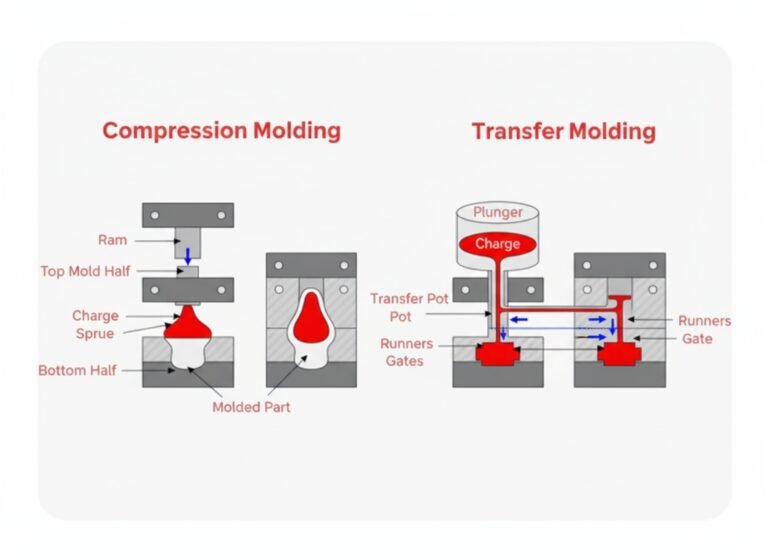In the world of manufacturing, plastic electroplating emerges as a transformative process, combining the resilience of plastics with the appearance of metal finishes. Commonly used in automotive, electronics, and consumer goods, it improves durability, wear resistance, and corrosion protection. This article will help you understand the essential aspects of plastic electroplating.
What is the Plastic Electroplating?
Plastic electroplating is a manufacturing process that applies a thin metallic layer onto a plastic part’s surfaces through electrochemical deposition. This method enhances the visual and functional properties of plastic components, making them more aesthetically pleasing, durable, and conductive. The process involves meticulously preparing the plastic substrate, applying a conductive layer, and then subjecting it to an electroplating bath where metal ions are deposited onto the surface.
Methods of Plastic Electroplating
1. Etching
Etching uses chemical baths or sandblasting to roughen the plastic surface, creating microscopic pits that improve adhesion. This step increases surface energy and allows catalysts and metal ions to bond effectively, making it a standard preparation method before further plating.
2. Electroless Plating
Electroless plating, also called chemical plating, deposits a thin layer of nickel or copper on the plastic through a catalytic reaction without electricity. It ensures an even coating on complex shapes, reduces porosity, and provides good hardness and corrosion resistance.
3. Conductive Coating + Electroplating
This method applies a thin layer of conductive paint, such as silver or graphite, directly on the plastic surface. Once conductive, the part can be electroplated with copper, nickel, chrome, or gold like a metal component, offering a straightforward way to achieve decorative and functional metallic finishes.
4. Flame Treatment
Flame treatment briefly exposes the plastic surface to a controlled gas flame, oxidizing it and raising surface energy for better coating adhesion. While effective, it requires careful handling to avoid deforming heat-sensitive plastics.
Commonly Used Metals in Plastic Electroplating
In plastic electroplating, both the plastic substrate and the metal coating are key to the final result. Common choices such as ABS, polycarbonate (PC), polypropylene (PP), and nylon (PA) can be etched or treated for strong metal adhesion. After selecting the plastic, the next step is choosing a suitable metal finish, which adds its properties while enhancing the performance and appearance of the part. Below are the metals most often used in plastic electroplating and their practical benefits.
Chrome (Chromium)
Chrome provides high hardness and strong corrosion resistance. When applied to plastic surfaces, it forms a durable, wear-resistant layer with a reflective metallic finish. It is commonly used in applications that require both durability and a polished appearance, such as automotive parts and consumer products.
Nickel
Nickel offers a smooth finish, good corrosion resistance, and stable hardness. On plastic parts, it increases wear resistance while giving a bright, uniform surface. Its versatility makes it suitable for both decorative coatings and protective functional layers.
Gold
Gold is conductive, malleable, and resistant to corrosion. Electroplating plastic with gold produces a visually refined finish while also providing conductivity, which is useful in electronic and communication components.
Copper
Copper combines good electrical conductivity with malleability. When electroplated onto plastics, it improves electrical performance and is often used where conductivity is required. Its metallic tone also contributes to an appealing decorative effect.
The Application of Plastic Electroplating

Plastic electroplating can combine the plastics’ versatility with the metallic finishes’ sophistication. And this manufacturing process finds widespread applications across various industries. Here are some sectors where the plastic electroplating process is commonly applied:
- Automotive Industry: Plastic grilles, trim, emblems, interior accents, dashboard elements, buttons, handles.
- Electronics: Plastic housings, enclosures, electronic components.
- Consumer Goods: Plastic parts in watches, handsets, and accessories.
- Appliances: Plastic panels, knobs, handles, control buttons.
- Lighting: Plastic lamp housings, decorative fixtures, and LED covers.
- Industrial Equipment: Connectors, switches, and protective covers.
- Medical Devices: Plastic parts for diagnostic or monitoring devices.
Advantages of Plastic Electroplating
1. Enhanced Appearance
Plastic electroplating provides a striking, often reflective metallic finish, significantly improving the visual appeal of plastic components. This makes it ideal for decorative automotive trims, consumer electronics, and fashion accessories.
2. Improved Durability and Wear Resistance
The metal layer formed through electroplating increases the durability of plastic surfaces and enhances resistance to wear and abrasion. This is particularly valuable for parts subjected to constant friction, such as automotive interior buttons or electronic device housings.
3. Increased Corrosion and Chemical Resistance
Electroplating acts as a protective barrier, shielding the underlying plastic from corrosion and chemical damage. This ensures longer service life, especially in harsh or corrosive environments.
4. Enhanced Structural Strength
The addition of a metal coating strengthens plastic components, improving their mechanical resilience and ability to withstand stress. This structural enhancement benefits applications in automotive, electronics, and industrial parts.
5. Improved Surface Uniformity and Stability
Electroplated surfaces are more uniform and consistent, contributing to better dimensional stability and consistent appearance across components. This is critical for high-precision parts in electronics and automotive interiors.
6. Enhanced Electrical Conductivity
By using conductive metals such as copper or nickel, electroplated plastics can carry electrical currents, making them suitable for electronic housings, connectors, and other functional components.
Challenges of Plastic Electroplating
Plastic electroplating provides decorative and functional metallic finishes, but achieving consistent quality goes far beyond surface appearance. Several challenges stem from the interaction between part design, mold, material, and process.
1. Complex Part Geometry
Sharp edges, tight corners, and intricate curves can create uneven plating. Metal tends to accumulate on protrusions, while recessed areas may receive too little coverage. Without careful design, these geometric features can cause plating defects or weak adhesion. Using rounded corners, smooth transitions, and proper draft angles helps maintain uniform metal deposition.
2. Mold Design and Ejection Issues
Improper mold design can leave residual stresses or damage the part during ejection. Sticking, warping, or minor cracks not only affect the plating process but also compromise mechanical integrity. Highly polished mold surfaces and well-planned ejector systems reduce these risks and support consistent quality.
3. Material Properties and Internal Porosity
Non-conductive plastics are sensitive to heat, chemicals, and mechanical stress. Variations in density or internal voids can lead to pinholes, peeling, or inconsistent plating thickness. Selecting materials with uniform density and controlling molding parameters are critical to avoid these structural weaknesses.
4. Surface Preparation and Contamination
Plating adhesion depends on meticulously clean surfaces. Mold release agents, dust, or oils—even in trace amounts—can cause defects like bubbles, blisters, or poor adhesion. Multi-step cleaning, chemical baths, and careful handling of molds and racks are essential to prepare the plastic surface for plating.
5. Process Control and Electrical Considerations
Achieving uniform metal coverage requires precise control of current density, anode placement, and bath conditions. Complex shapes or deep recesses can create shadow zones where plating is thin or inconsistent. Constant monitoring of bath composition, temperature, and electrical parameters ensures predictable results.
6. Thermal and Mechanical Sensitivity
Plastics can warp or crack under improper temperature or handling during electroplating. Even small deviations can introduce stresses that reduce adhesion and surface quality. Consistent process conditions and careful handling are key to preserving both form and function.
Conclusion
Plastic electroplating enhances both the appearance and performance of plastic components, improving durability, strength, and design quality. At Zhongde, we provide professional surface finish services, including secondary surface finishes, to help you achieve high-quality, reliable plated parts.



